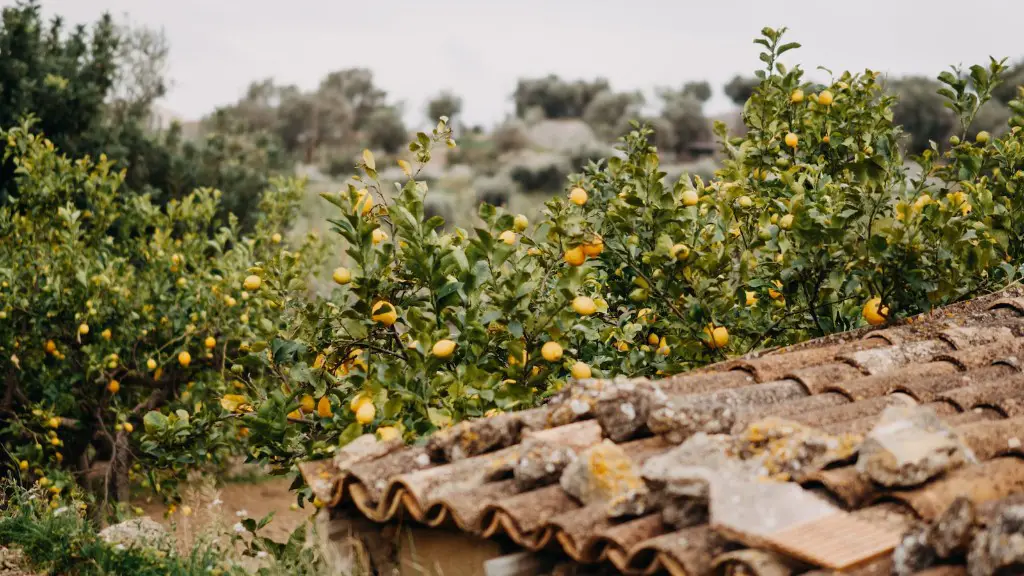In order to protect lemon trees from freeze, there are several steps that should be taken. Firstly, consider the location of the tree and choose a suitable site. If the tree is situated in a place where the temperature is expected to drop significantly during the cold season, it should be planted in a warm and sheltered location. Securing a location with sufficient sunlight is also important since lemon trees need a lot of sunlight in order to produce healthy lemons.
Secondly, the soil surrounding the tree should be well-drained. Adding compost or mulch to the soil can help absorb water, maintain a consistent temperature, and increase soil fertility. This will also provide the tree with vital nutrients and a more favourable environment for growth.
Thirdly, it’s important to prune the lemon tree properly. Prune away dead branches, keep the canopy shape spherical but open, and prune thick branches that are prone to break under heavy snow and ice. Pruning in this way reduces the load on the rootstock and helps protect the tree from frozen branches.
Fourthly and most importantly, provide the tree with some kind of sheltering during cold winter months. Covering the tree with a frost cloth or burlap will prevent cold air from getting directly to the tree and can keep the temperature around the tree a few degrees higher. It’s also a good idea to construct a structure such as an arbor, a fence, or a wall to provide some additional wind protection.
Lastly, water the tree often, especially during times of extreme heat. Proper watering will help keep the tree healthy and nourish the roots, which can help the tree better survive cold conditions. Furthermore, it’s recommended to apply a layer of protective material, such as wood or cardboard, around the trunk of the tree to help insulate the root system.
Water the Tree Frequently
Watering your lemon tree is essential in protecting it from freezing temperatures. Frequent watering is especially important during hot weather and before cold temperatures arrive, as doing so will keep the roots hydrated and healthy. Consider fitting a sprinkler system to make sure the tree receives enough water every week to keep it in peak condition. Regularly clean the sprinkler system to make sure that it’s running at its best.
Nutrients are also necessary for the health of the lemon tree and the soil surrounding it. Adding fertilizers or organic material to the soil can help provide extra nutrients and aid in the growth of the tree, as well as increase water retention, which is especially important during cold weather. Additionally, examine the soil periodically for signs of any problems, such as drainage and salt build-up, and alleviate them promptly.
Finally, avoid stressing the lemon tree by planting it in a spot that’s free from strong winds and direct sunlight. When choosing a spot to plant the tree, opt for an area that’s sheltered and surrounded by trees, so that the wind is redirected away from it. In addition, be mindful of the temperature swings in your area and modify your tree management accordingly.
Ensure Adequate Sunlight
Lemon trees require plenty of sunshine; however, full sun exposure is a double-edged sword, since it can make the tree more vulnerable to the cold temperatures. To help the tree survive from damage caused by extreme cold, place the tree in a spot where it will only receive partial sun, ideally for several hours in the morning and in the afternoon. Planting the tree in the middle of an open space with no shelter will increase its chances of freezing.
To increase protection from cold temperatures, it’s important to create an area of insulation around the tree. Using wood or other similar materials, build a structure that will provide extra protection from direct contact with the cold air. Additionally, adding windbreakers to the structure, such as branches or other natural materials, will further protect the tree from cold winds.
Once the structure is built, it’s necessary to also insulate the soil. Lay a layer of mulch or straw on the ground around the tree to trap the heat and prevent it from dissipating. The additional warmth provided by the layer of air covering the soil will help to keep the roots of the tree warm and protect them from freezing.
Trim the Tree Properly
Lemon trees should also be trimmed regularly. Prune away any dead branches and harvest any dead fruits to allow new lemons to grow. This will help avoid extra damage from a heavy snowfall or ice on the branches. Furthermore, when pruning the tree, focus on creating an open, spherical shape that will offer the least resistance to strong winds or a heavy snowfall. Pruning the tree in this way reduces the load on the rootstock, helping it protect against frost.
In addition to pruning, it’s also important to use some kind of material to provide extra protection. Covering the tree with a tarp or plastic sheet can help prevent cold air from getting directly to the tree and reducing the temperature around the plant. Alternatively, build a tile or board shelter to provide extra protection to the tree.
Finally, avoid placing too many lemons on the tree, as this can cause the tree to be weighed down and snap in cold weather. When harvesting lemons, leave a few on the tree to stimulate its growth and the production of healthy fruit. Be mindful of extreme temperatures and the size of the tree to ensure that it’s not overloaded with lemons.
Optimize the Soil
The soil around the tree should also be kept in good condition in order to protect it from freezing. Applying organic material and compost to the soil will improve drainage and aeration, leading to healthier trees that can stand up to temperature changes better. Furthermore, adding a layer of mulch will help insulate the roots from the cold and provide additional nutrients.
The soil should also be examined periodically for the presence of pests and diseases, as these can harm the lemon tree. If any of these are spotted, use appropriate treatments to get rid of them promptly. Soil amendments, such as lime or sulfur, can also be used to improve acidity levels and provide extra protection. Additionally, when transplanting the tree, consider its root structure and pick a spot where the tree will be in the best environment for optimal growth.
Additional Protection
When protecting a lemon tree from freezing temperatures, extra precautions should be taken. Watering the tree deeply and less often will help maintain a consistent temperature in the ground and encourage deeper roots that are bound to be more sheltered during winter. Additionally, applying fertilizers during spring and summer will help the tree during its dormant periods, ensuring a strong and healthy tree.
Buying a good-quality protective frost curtain is also recommended. This thick material, usually made of polypropylene fabric, will help keep the lemon tree warm and can be easily attached around the tree’s trunk and branches. Furthermore, covering the tree with fleece or a blanket will also provide additional protection in winter and help maintain a consistent temperature.
Finally, take extra care during cold weather and be aware of sudden temperature drops. If a frost is expected, cover the tree with a protective layer of material, such as cardboard or wood, to trap the heat and reduce the risk of damage caused by the cold. Pay close attention to the tree and adjust the care practices whenever necessary.



